Critical Thinking in Management: Employee Social Media Issue
VerifiedAdded on 2020/05/08
|11
|2475
|324
Report
AI Summary
This report examines a case study involving Downcity Motors, where an employee's negative social media posts are causing reputational damage. The report explores the dilemma faced by the senior management in deciding how to address the issue, considering the lack of a specific social media policy. It identifies and analyzes potential solutions, including firing the employee, ignoring the issue, or initiating disciplinary actions while addressing the employee's grievances. The report concludes that effective communication, understanding the employee's concerns, and fostering a positive work environment are the most beneficial approaches. Recommendations include implementing an effective communication policy and enhancing the organizational culture to increase employee motivation. The report emphasizes the importance of addressing employee issues promptly to prevent similar incidents in the future.
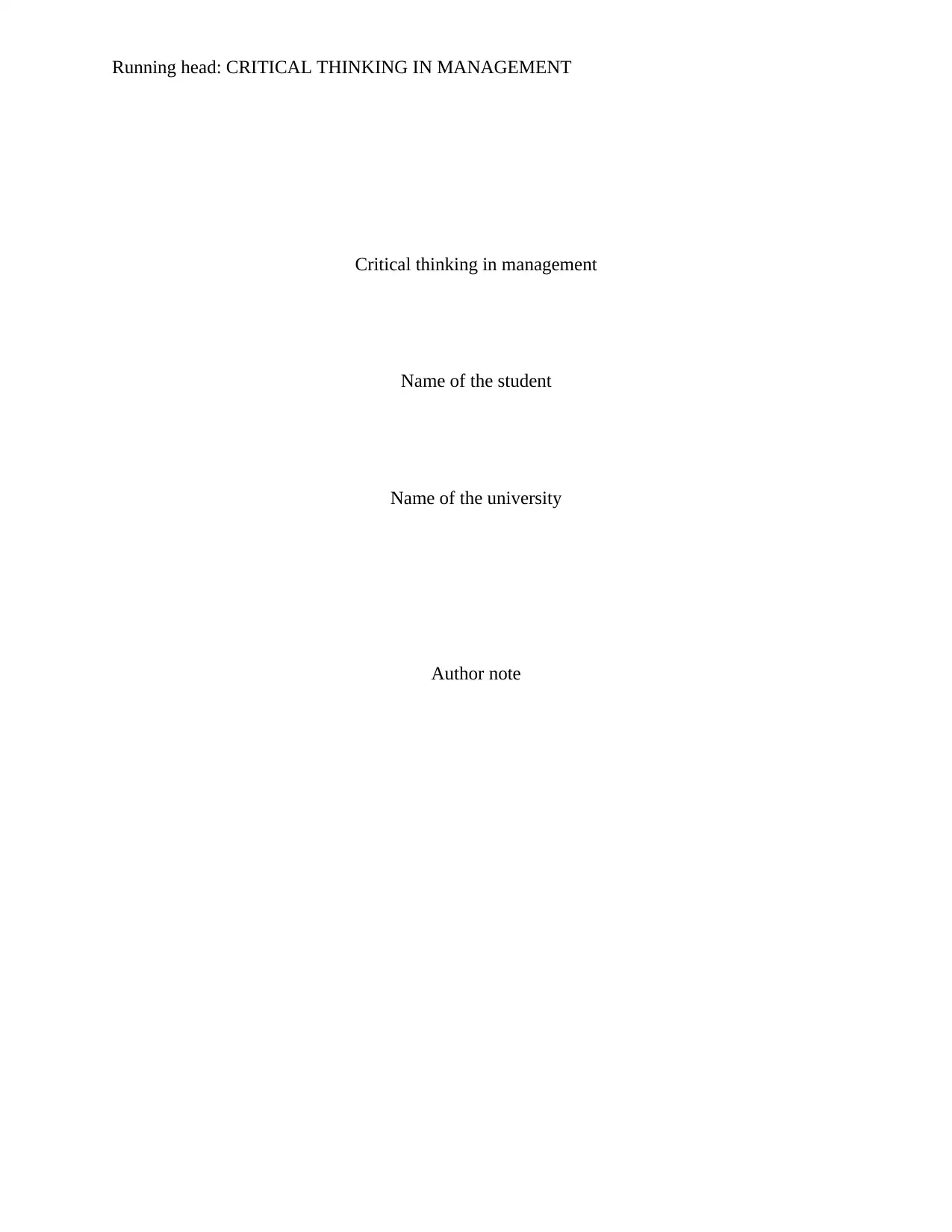
Running head: CRITICAL THINKING IN MANAGEMENT
Critical thinking in management
Name of the student
Name of the university
Author note
Critical thinking in management
Name of the student
Name of the university
Author note
Paraphrase This Document
Need a fresh take? Get an instant paraphrase of this document with our AI Paraphraser
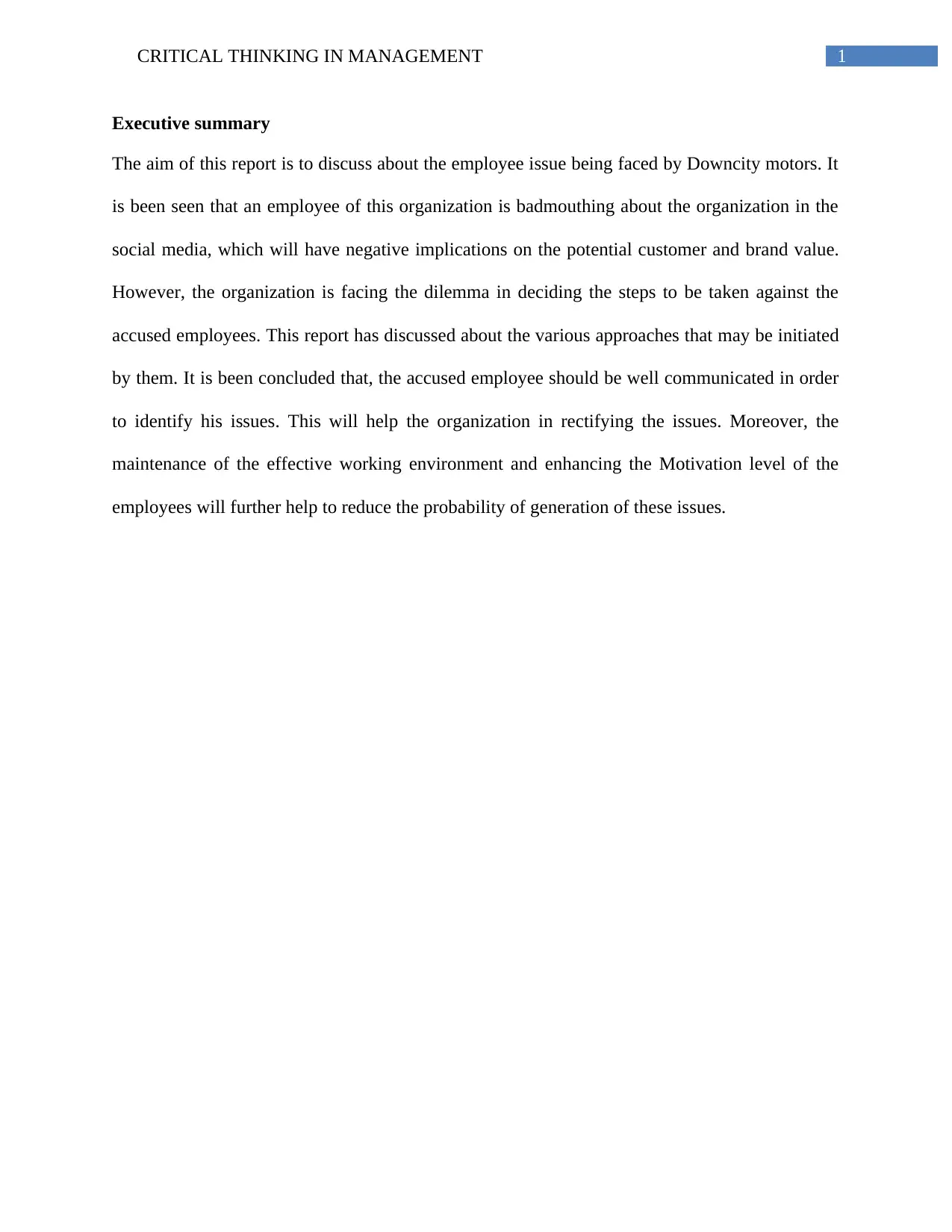
1CRITICAL THINKING IN MANAGEMENT
Executive summary
The aim of this report is to discuss about the employee issue being faced by Downcity motors. It
is been seen that an employee of this organization is badmouthing about the organization in the
social media, which will have negative implications on the potential customer and brand value.
However, the organization is facing the dilemma in deciding the steps to be taken against the
accused employees. This report has discussed about the various approaches that may be initiated
by them. It is been concluded that, the accused employee should be well communicated in order
to identify his issues. This will help the organization in rectifying the issues. Moreover, the
maintenance of the effective working environment and enhancing the Motivation level of the
employees will further help to reduce the probability of generation of these issues.
Executive summary
The aim of this report is to discuss about the employee issue being faced by Downcity motors. It
is been seen that an employee of this organization is badmouthing about the organization in the
social media, which will have negative implications on the potential customer and brand value.
However, the organization is facing the dilemma in deciding the steps to be taken against the
accused employees. This report has discussed about the various approaches that may be initiated
by them. It is been concluded that, the accused employee should be well communicated in order
to identify his issues. This will help the organization in rectifying the issues. Moreover, the
maintenance of the effective working environment and enhancing the Motivation level of the
employees will further help to reduce the probability of generation of these issues.

2CRITICAL THINKING IN MANAGEMENT
Table of Contents
Introduction......................................................................................................................................3
Case scenario...................................................................................................................................4
Identified solutions..........................................................................................................................5
Recommendations............................................................................................................................7
Conclusion.......................................................................................................................................8
Reference.........................................................................................................................................9
Table of Contents
Introduction......................................................................................................................................3
Case scenario...................................................................................................................................4
Identified solutions..........................................................................................................................5
Recommendations............................................................................................................................7
Conclusion.......................................................................................................................................8
Reference.........................................................................................................................................9
⊘ This is a preview!⊘
Do you want full access?
Subscribe today to unlock all pages.

Trusted by 1+ million students worldwide
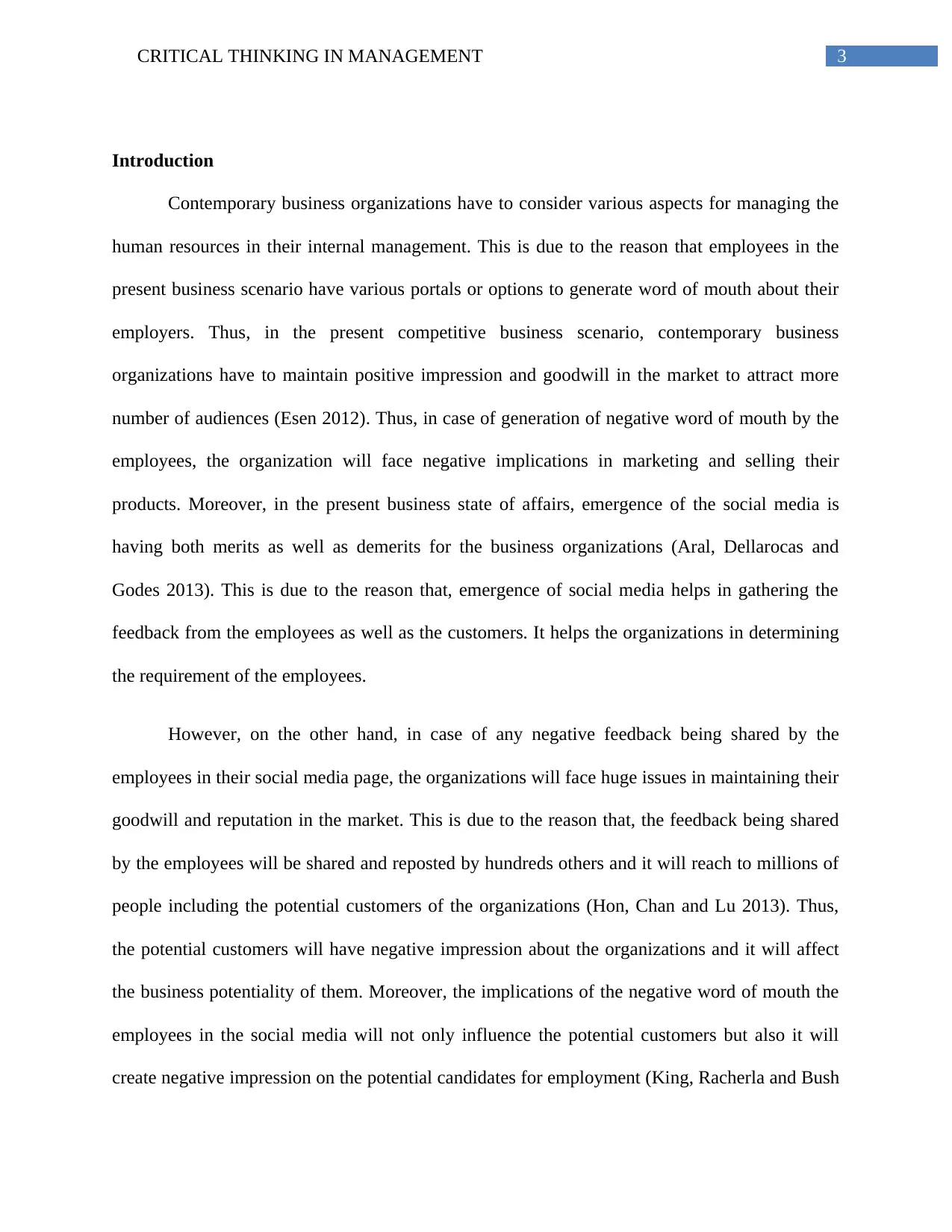
3CRITICAL THINKING IN MANAGEMENT
Introduction
Contemporary business organizations have to consider various aspects for managing the
human resources in their internal management. This is due to the reason that employees in the
present business scenario have various portals or options to generate word of mouth about their
employers. Thus, in the present competitive business scenario, contemporary business
organizations have to maintain positive impression and goodwill in the market to attract more
number of audiences (Esen 2012). Thus, in case of generation of negative word of mouth by the
employees, the organization will face negative implications in marketing and selling their
products. Moreover, in the present business state of affairs, emergence of the social media is
having both merits as well as demerits for the business organizations (Aral, Dellarocas and
Godes 2013). This is due to the reason that, emergence of social media helps in gathering the
feedback from the employees as well as the customers. It helps the organizations in determining
the requirement of the employees.
However, on the other hand, in case of any negative feedback being shared by the
employees in their social media page, the organizations will face huge issues in maintaining their
goodwill and reputation in the market. This is due to the reason that, the feedback being shared
by the employees will be shared and reposted by hundreds others and it will reach to millions of
people including the potential customers of the organizations (Hon, Chan and Lu 2013). Thus,
the potential customers will have negative impression about the organizations and it will affect
the business potentiality of them. Moreover, the implications of the negative word of mouth the
employees in the social media will not only influence the potential customers but also it will
create negative impression on the potential candidates for employment (King, Racherla and Bush
Introduction
Contemporary business organizations have to consider various aspects for managing the
human resources in their internal management. This is due to the reason that employees in the
present business scenario have various portals or options to generate word of mouth about their
employers. Thus, in the present competitive business scenario, contemporary business
organizations have to maintain positive impression and goodwill in the market to attract more
number of audiences (Esen 2012). Thus, in case of generation of negative word of mouth by the
employees, the organization will face negative implications in marketing and selling their
products. Moreover, in the present business state of affairs, emergence of the social media is
having both merits as well as demerits for the business organizations (Aral, Dellarocas and
Godes 2013). This is due to the reason that, emergence of social media helps in gathering the
feedback from the employees as well as the customers. It helps the organizations in determining
the requirement of the employees.
However, on the other hand, in case of any negative feedback being shared by the
employees in their social media page, the organizations will face huge issues in maintaining their
goodwill and reputation in the market. This is due to the reason that, the feedback being shared
by the employees will be shared and reposted by hundreds others and it will reach to millions of
people including the potential customers of the organizations (Hon, Chan and Lu 2013). Thus,
the potential customers will have negative impression about the organizations and it will affect
the business potentiality of them. Moreover, the implications of the negative word of mouth the
employees in the social media will not only influence the potential customers but also it will
create negative impression on the potential candidates for employment (King, Racherla and Bush
Paraphrase This Document
Need a fresh take? Get an instant paraphrase of this document with our AI Paraphraser
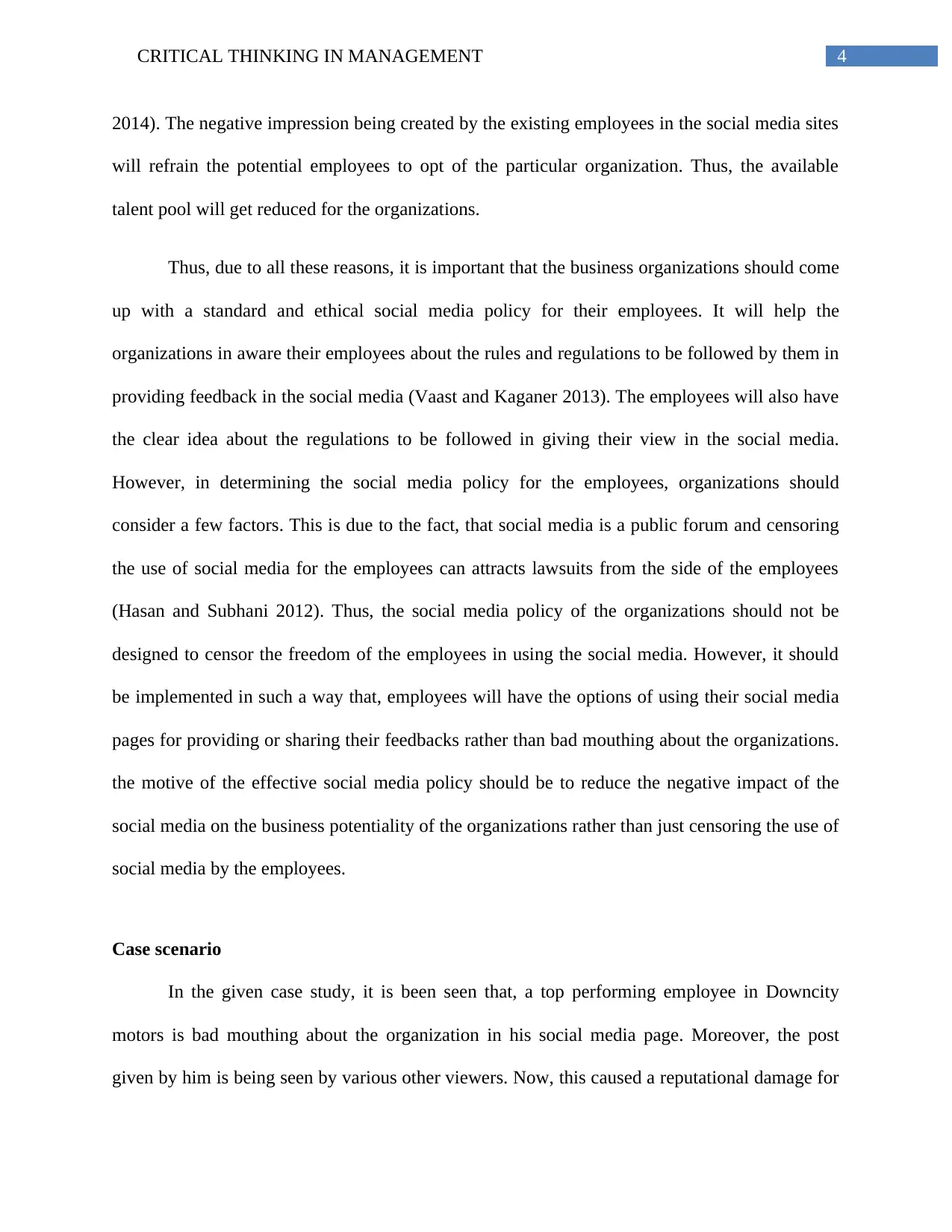
4CRITICAL THINKING IN MANAGEMENT
2014). The negative impression being created by the existing employees in the social media sites
will refrain the potential employees to opt of the particular organization. Thus, the available
talent pool will get reduced for the organizations.
Thus, due to all these reasons, it is important that the business organizations should come
up with a standard and ethical social media policy for their employees. It will help the
organizations in aware their employees about the rules and regulations to be followed by them in
providing feedback in the social media (Vaast and Kaganer 2013). The employees will also have
the clear idea about the regulations to be followed in giving their view in the social media.
However, in determining the social media policy for the employees, organizations should
consider a few factors. This is due to the fact, that social media is a public forum and censoring
the use of social media for the employees can attracts lawsuits from the side of the employees
(Hasan and Subhani 2012). Thus, the social media policy of the organizations should not be
designed to censor the freedom of the employees in using the social media. However, it should
be implemented in such a way that, employees will have the options of using their social media
pages for providing or sharing their feedbacks rather than bad mouthing about the organizations.
the motive of the effective social media policy should be to reduce the negative impact of the
social media on the business potentiality of the organizations rather than just censoring the use of
social media by the employees.
Case scenario
In the given case study, it is been seen that, a top performing employee in Downcity
motors is bad mouthing about the organization in his social media page. Moreover, the post
given by him is being seen by various other viewers. Now, this caused a reputational damage for
2014). The negative impression being created by the existing employees in the social media sites
will refrain the potential employees to opt of the particular organization. Thus, the available
talent pool will get reduced for the organizations.
Thus, due to all these reasons, it is important that the business organizations should come
up with a standard and ethical social media policy for their employees. It will help the
organizations in aware their employees about the rules and regulations to be followed by them in
providing feedback in the social media (Vaast and Kaganer 2013). The employees will also have
the clear idea about the regulations to be followed in giving their view in the social media.
However, in determining the social media policy for the employees, organizations should
consider a few factors. This is due to the fact, that social media is a public forum and censoring
the use of social media for the employees can attracts lawsuits from the side of the employees
(Hasan and Subhani 2012). Thus, the social media policy of the organizations should not be
designed to censor the freedom of the employees in using the social media. However, it should
be implemented in such a way that, employees will have the options of using their social media
pages for providing or sharing their feedbacks rather than bad mouthing about the organizations.
the motive of the effective social media policy should be to reduce the negative impact of the
social media on the business potentiality of the organizations rather than just censoring the use of
social media by the employees.
Case scenario
In the given case study, it is been seen that, a top performing employee in Downcity
motors is bad mouthing about the organization in his social media page. Moreover, the post
given by him is being seen by various other viewers. Now, this caused a reputational damage for
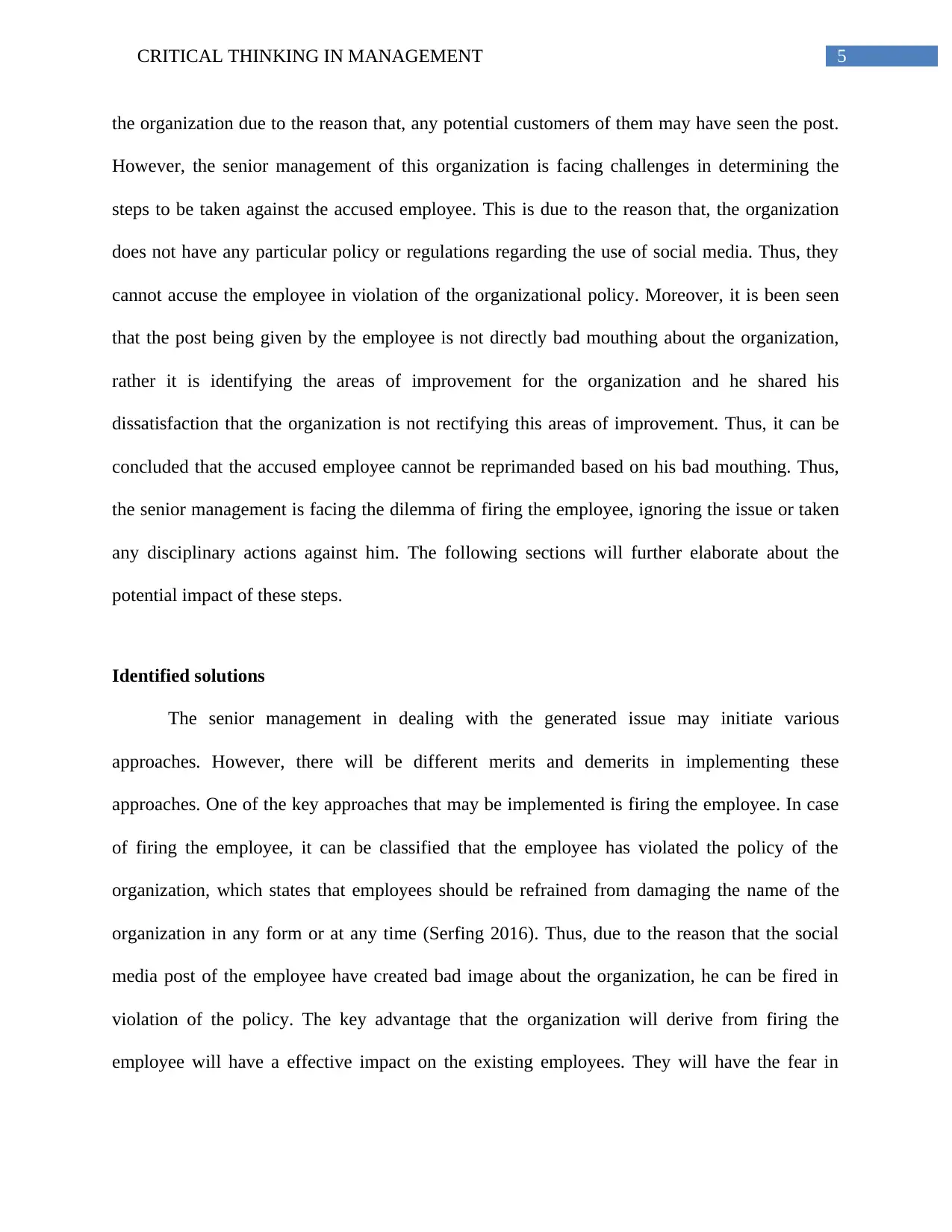
5CRITICAL THINKING IN MANAGEMENT
the organization due to the reason that, any potential customers of them may have seen the post.
However, the senior management of this organization is facing challenges in determining the
steps to be taken against the accused employee. This is due to the reason that, the organization
does not have any particular policy or regulations regarding the use of social media. Thus, they
cannot accuse the employee in violation of the organizational policy. Moreover, it is been seen
that the post being given by the employee is not directly bad mouthing about the organization,
rather it is identifying the areas of improvement for the organization and he shared his
dissatisfaction that the organization is not rectifying this areas of improvement. Thus, it can be
concluded that the accused employee cannot be reprimanded based on his bad mouthing. Thus,
the senior management is facing the dilemma of firing the employee, ignoring the issue or taken
any disciplinary actions against him. The following sections will further elaborate about the
potential impact of these steps.
Identified solutions
The senior management in dealing with the generated issue may initiate various
approaches. However, there will be different merits and demerits in implementing these
approaches. One of the key approaches that may be implemented is firing the employee. In case
of firing the employee, it can be classified that the employee has violated the policy of the
organization, which states that employees should be refrained from damaging the name of the
organization in any form or at any time (Serfing 2016). Thus, due to the reason that the social
media post of the employee have created bad image about the organization, he can be fired in
violation of the policy. The key advantage that the organization will derive from firing the
employee will have a effective impact on the existing employees. They will have the fear in
the organization due to the reason that, any potential customers of them may have seen the post.
However, the senior management of this organization is facing challenges in determining the
steps to be taken against the accused employee. This is due to the reason that, the organization
does not have any particular policy or regulations regarding the use of social media. Thus, they
cannot accuse the employee in violation of the organizational policy. Moreover, it is been seen
that the post being given by the employee is not directly bad mouthing about the organization,
rather it is identifying the areas of improvement for the organization and he shared his
dissatisfaction that the organization is not rectifying this areas of improvement. Thus, it can be
concluded that the accused employee cannot be reprimanded based on his bad mouthing. Thus,
the senior management is facing the dilemma of firing the employee, ignoring the issue or taken
any disciplinary actions against him. The following sections will further elaborate about the
potential impact of these steps.
Identified solutions
The senior management in dealing with the generated issue may initiate various
approaches. However, there will be different merits and demerits in implementing these
approaches. One of the key approaches that may be implemented is firing the employee. In case
of firing the employee, it can be classified that the employee has violated the policy of the
organization, which states that employees should be refrained from damaging the name of the
organization in any form or at any time (Serfing 2016). Thus, due to the reason that the social
media post of the employee have created bad image about the organization, he can be fired in
violation of the policy. The key advantage that the organization will derive from firing the
employee will have a effective impact on the existing employees. They will have the fear in
⊘ This is a preview!⊘
Do you want full access?
Subscribe today to unlock all pages.

Trusted by 1+ million students worldwide

6CRITICAL THINKING IN MANAGEMENT
sharing something negative about the organization in the social media in future. Moreover, the
generated issue can be solved at one go without further extending it.
However, there will be various disadvantages also in implementing this approach. This is
due to the reason that, firing the employee will only increase the dissatisfaction of the employee.
Moreover, by firing him, the organization will offer him free hand in badmouthing the
organization (Monroy and Rieders 2014). He will not have any regulations to deter him from
sharing negative word of mouth regarding the organization in the social media. Thus, the issue
will not get solved by firing the employee and moreover, it will get increase due to this approach.
The second approach will be to ignore the issue. This approach will also have various
advantages as well as disadvantages. One of the key merits of this approach will be non-
involvement of the senior management in the issue, which will not magnify the issue further. In
addition, ignoring the issue will create an impression on the employee that the organization is not
giving value to his social media disclosure of dissatisfaction (Gomathi 2014). Thus, he will also
reduce disclosing his dissatisfaction in the social media. However, on the other hand, this
approach will have demerits also. One of the key demerits will be the ineffective impression on
the existing employees. The existing workforce will have the impression that if they will also
badmouth about the organization in social media then they will also be spared with having any
consequences. Thus, the senior management will not have any control or regulations over the
activities of the employees.
The last approach is initiation of disciplinary actions against the employee along with
identifying and rectifying the issues with him. This will be the most effective approach in dealing
with the emerged issue. In this case, the employee should be well communicated by the senior
sharing something negative about the organization in the social media in future. Moreover, the
generated issue can be solved at one go without further extending it.
However, there will be various disadvantages also in implementing this approach. This is
due to the reason that, firing the employee will only increase the dissatisfaction of the employee.
Moreover, by firing him, the organization will offer him free hand in badmouthing the
organization (Monroy and Rieders 2014). He will not have any regulations to deter him from
sharing negative word of mouth regarding the organization in the social media. Thus, the issue
will not get solved by firing the employee and moreover, it will get increase due to this approach.
The second approach will be to ignore the issue. This approach will also have various
advantages as well as disadvantages. One of the key merits of this approach will be non-
involvement of the senior management in the issue, which will not magnify the issue further. In
addition, ignoring the issue will create an impression on the employee that the organization is not
giving value to his social media disclosure of dissatisfaction (Gomathi 2014). Thus, he will also
reduce disclosing his dissatisfaction in the social media. However, on the other hand, this
approach will have demerits also. One of the key demerits will be the ineffective impression on
the existing employees. The existing workforce will have the impression that if they will also
badmouth about the organization in social media then they will also be spared with having any
consequences. Thus, the senior management will not have any control or regulations over the
activities of the employees.
The last approach is initiation of disciplinary actions against the employee along with
identifying and rectifying the issues with him. This will be the most effective approach in dealing
with the emerged issue. In this case, the employee should be well communicated by the senior
Paraphrase This Document
Need a fresh take? Get an instant paraphrase of this document with our AI Paraphraser
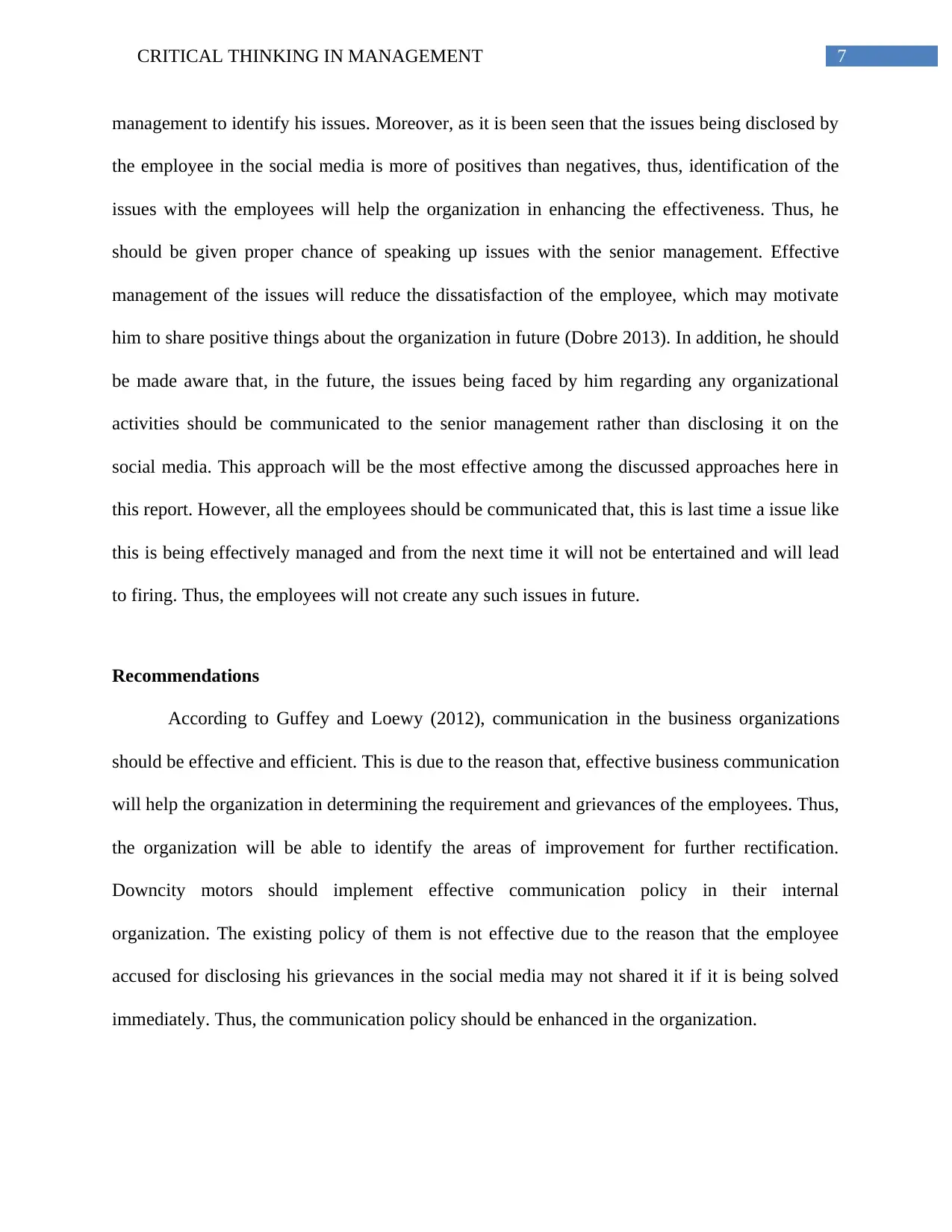
7CRITICAL THINKING IN MANAGEMENT
management to identify his issues. Moreover, as it is been seen that the issues being disclosed by
the employee in the social media is more of positives than negatives, thus, identification of the
issues with the employees will help the organization in enhancing the effectiveness. Thus, he
should be given proper chance of speaking up issues with the senior management. Effective
management of the issues will reduce the dissatisfaction of the employee, which may motivate
him to share positive things about the organization in future (Dobre 2013). In addition, he should
be made aware that, in the future, the issues being faced by him regarding any organizational
activities should be communicated to the senior management rather than disclosing it on the
social media. This approach will be the most effective among the discussed approaches here in
this report. However, all the employees should be communicated that, this is last time a issue like
this is being effectively managed and from the next time it will not be entertained and will lead
to firing. Thus, the employees will not create any such issues in future.
Recommendations
According to Guffey and Loewy (2012), communication in the business organizations
should be effective and efficient. This is due to the reason that, effective business communication
will help the organization in determining the requirement and grievances of the employees. Thus,
the organization will be able to identify the areas of improvement for further rectification.
Downcity motors should implement effective communication policy in their internal
organization. The existing policy of them is not effective due to the reason that the employee
accused for disclosing his grievances in the social media may not shared it if it is being solved
immediately. Thus, the communication policy should be enhanced in the organization.
management to identify his issues. Moreover, as it is been seen that the issues being disclosed by
the employee in the social media is more of positives than negatives, thus, identification of the
issues with the employees will help the organization in enhancing the effectiveness. Thus, he
should be given proper chance of speaking up issues with the senior management. Effective
management of the issues will reduce the dissatisfaction of the employee, which may motivate
him to share positive things about the organization in future (Dobre 2013). In addition, he should
be made aware that, in the future, the issues being faced by him regarding any organizational
activities should be communicated to the senior management rather than disclosing it on the
social media. This approach will be the most effective among the discussed approaches here in
this report. However, all the employees should be communicated that, this is last time a issue like
this is being effectively managed and from the next time it will not be entertained and will lead
to firing. Thus, the employees will not create any such issues in future.
Recommendations
According to Guffey and Loewy (2012), communication in the business organizations
should be effective and efficient. This is due to the reason that, effective business communication
will help the organization in determining the requirement and grievances of the employees. Thus,
the organization will be able to identify the areas of improvement for further rectification.
Downcity motors should implement effective communication policy in their internal
organization. The existing policy of them is not effective due to the reason that the employee
accused for disclosing his grievances in the social media may not shared it if it is being solved
immediately. Thus, the communication policy should be enhanced in the organization.
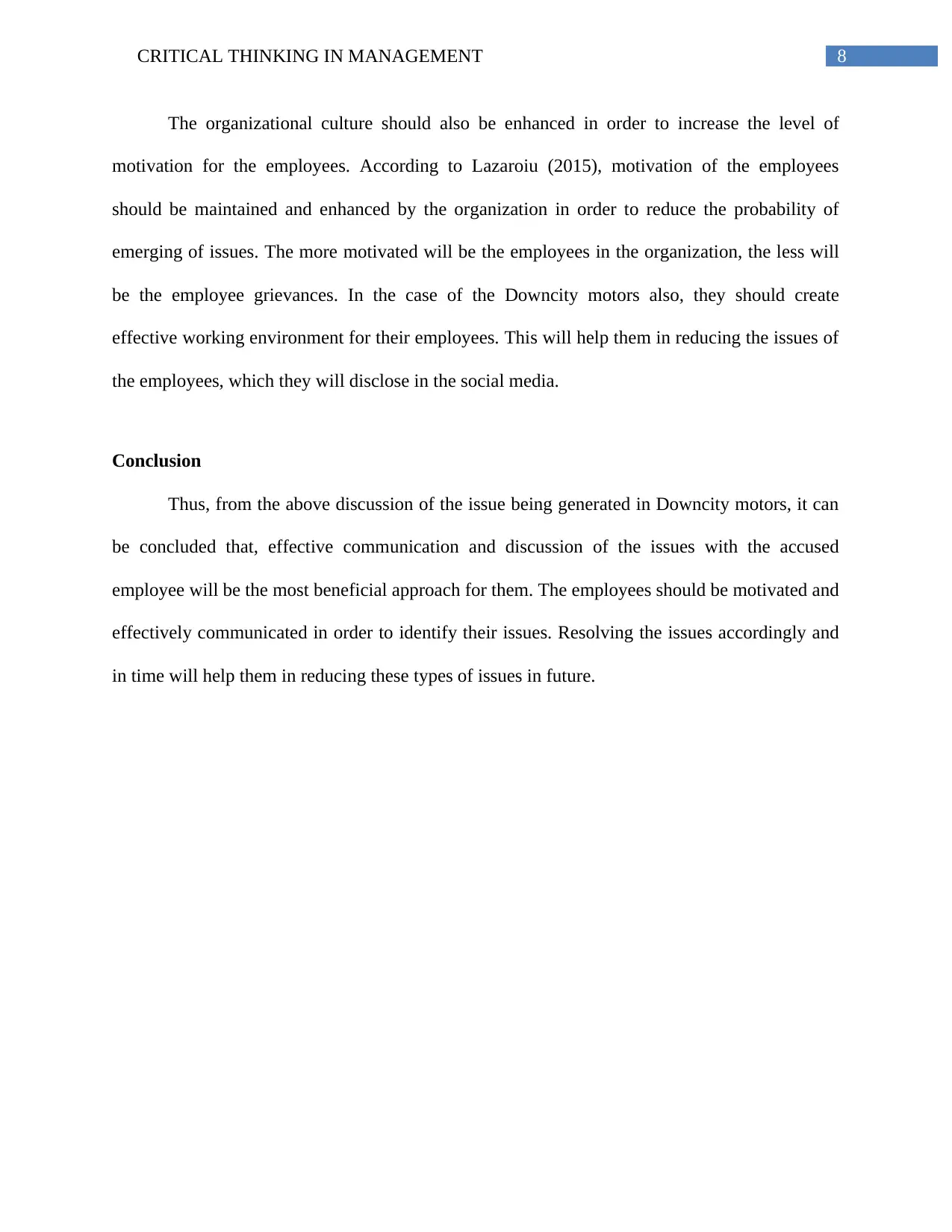
8CRITICAL THINKING IN MANAGEMENT
The organizational culture should also be enhanced in order to increase the level of
motivation for the employees. According to Lazaroiu (2015), motivation of the employees
should be maintained and enhanced by the organization in order to reduce the probability of
emerging of issues. The more motivated will be the employees in the organization, the less will
be the employee grievances. In the case of the Downcity motors also, they should create
effective working environment for their employees. This will help them in reducing the issues of
the employees, which they will disclose in the social media.
Conclusion
Thus, from the above discussion of the issue being generated in Downcity motors, it can
be concluded that, effective communication and discussion of the issues with the accused
employee will be the most beneficial approach for them. The employees should be motivated and
effectively communicated in order to identify their issues. Resolving the issues accordingly and
in time will help them in reducing these types of issues in future.
The organizational culture should also be enhanced in order to increase the level of
motivation for the employees. According to Lazaroiu (2015), motivation of the employees
should be maintained and enhanced by the organization in order to reduce the probability of
emerging of issues. The more motivated will be the employees in the organization, the less will
be the employee grievances. In the case of the Downcity motors also, they should create
effective working environment for their employees. This will help them in reducing the issues of
the employees, which they will disclose in the social media.
Conclusion
Thus, from the above discussion of the issue being generated in Downcity motors, it can
be concluded that, effective communication and discussion of the issues with the accused
employee will be the most beneficial approach for them. The employees should be motivated and
effectively communicated in order to identify their issues. Resolving the issues accordingly and
in time will help them in reducing these types of issues in future.
⊘ This is a preview!⊘
Do you want full access?
Subscribe today to unlock all pages.

Trusted by 1+ million students worldwide
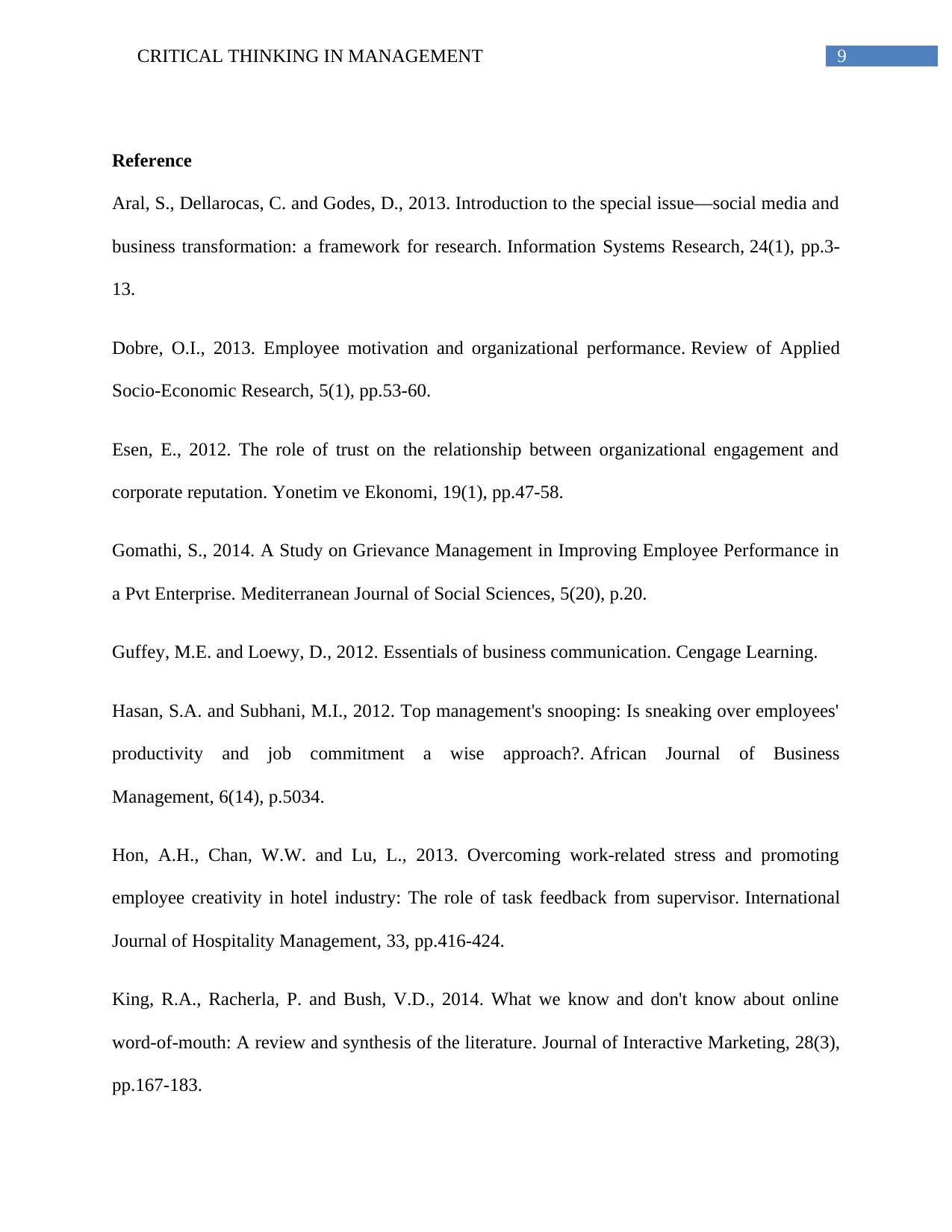
9CRITICAL THINKING IN MANAGEMENT
Reference
Aral, S., Dellarocas, C. and Godes, D., 2013. Introduction to the special issue—social media and
business transformation: a framework for research. Information Systems Research, 24(1), pp.3-
13.
Dobre, O.I., 2013. Employee motivation and organizational performance. Review of Applied
Socio-Economic Research, 5(1), pp.53-60.
Esen, E., 2012. The role of trust on the relationship between organizational engagement and
corporate reputation. Yonetim ve Ekonomi, 19(1), pp.47-58.
Gomathi, S., 2014. A Study on Grievance Management in Improving Employee Performance in
a Pvt Enterprise. Mediterranean Journal of Social Sciences, 5(20), p.20.
Guffey, M.E. and Loewy, D., 2012. Essentials of business communication. Cengage Learning.
Hasan, S.A. and Subhani, M.I., 2012. Top management's snooping: Is sneaking over employees'
productivity and job commitment a wise approach?. African Journal of Business
Management, 6(14), p.5034.
Hon, A.H., Chan, W.W. and Lu, L., 2013. Overcoming work-related stress and promoting
employee creativity in hotel industry: The role of task feedback from supervisor. International
Journal of Hospitality Management, 33, pp.416-424.
King, R.A., Racherla, P. and Bush, V.D., 2014. What we know and don't know about online
word-of-mouth: A review and synthesis of the literature. Journal of Interactive Marketing, 28(3),
pp.167-183.
Reference
Aral, S., Dellarocas, C. and Godes, D., 2013. Introduction to the special issue—social media and
business transformation: a framework for research. Information Systems Research, 24(1), pp.3-
13.
Dobre, O.I., 2013. Employee motivation and organizational performance. Review of Applied
Socio-Economic Research, 5(1), pp.53-60.
Esen, E., 2012. The role of trust on the relationship between organizational engagement and
corporate reputation. Yonetim ve Ekonomi, 19(1), pp.47-58.
Gomathi, S., 2014. A Study on Grievance Management in Improving Employee Performance in
a Pvt Enterprise. Mediterranean Journal of Social Sciences, 5(20), p.20.
Guffey, M.E. and Loewy, D., 2012. Essentials of business communication. Cengage Learning.
Hasan, S.A. and Subhani, M.I., 2012. Top management's snooping: Is sneaking over employees'
productivity and job commitment a wise approach?. African Journal of Business
Management, 6(14), p.5034.
Hon, A.H., Chan, W.W. and Lu, L., 2013. Overcoming work-related stress and promoting
employee creativity in hotel industry: The role of task feedback from supervisor. International
Journal of Hospitality Management, 33, pp.416-424.
King, R.A., Racherla, P. and Bush, V.D., 2014. What we know and don't know about online
word-of-mouth: A review and synthesis of the literature. Journal of Interactive Marketing, 28(3),
pp.167-183.
Paraphrase This Document
Need a fresh take? Get an instant paraphrase of this document with our AI Paraphraser
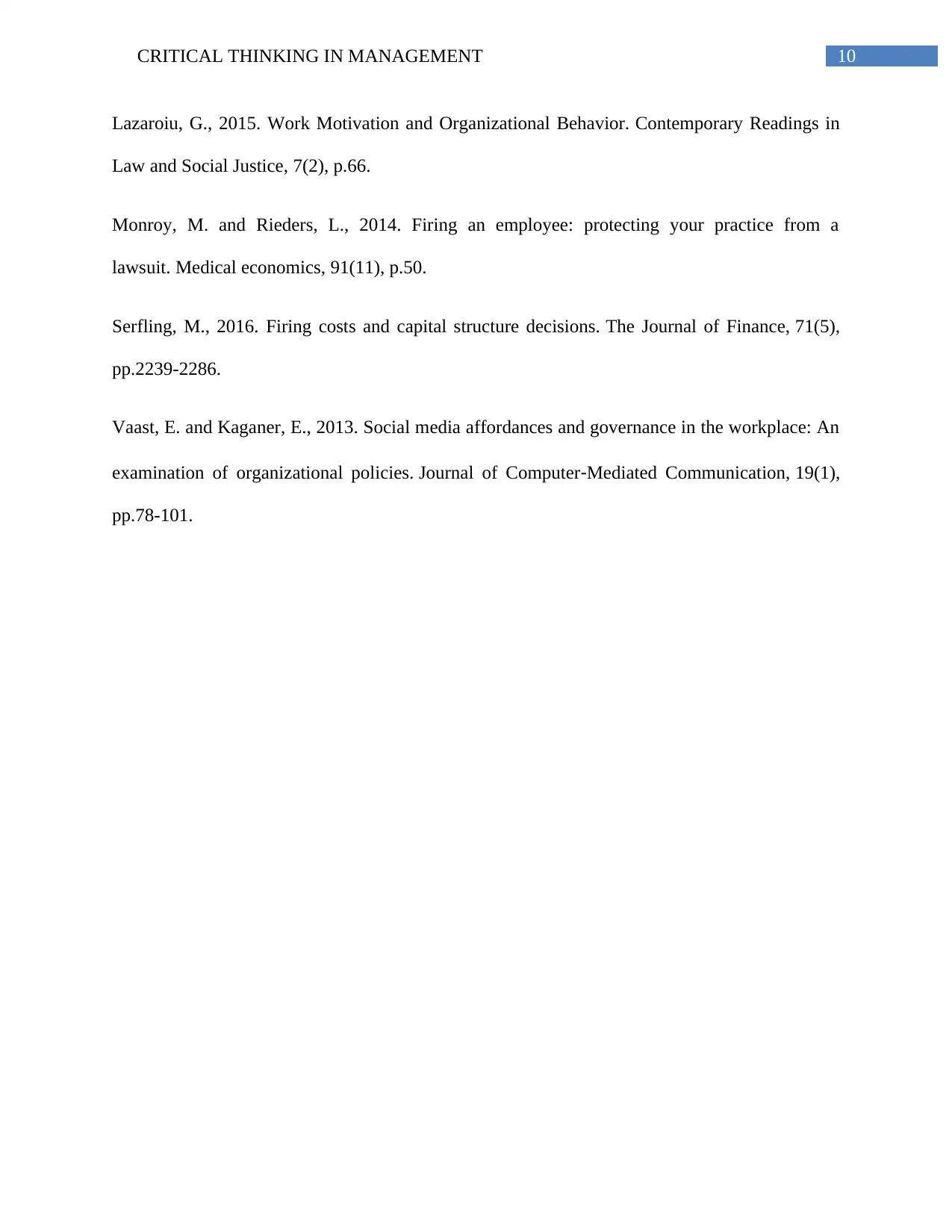
10CRITICAL THINKING IN MANAGEMENT
Lazaroiu, G., 2015. Work Motivation and Organizational Behavior. Contemporary Readings in
Law and Social Justice, 7(2), p.66.
Monroy, M. and Rieders, L., 2014. Firing an employee: protecting your practice from a
lawsuit. Medical economics, 91(11), p.50.
Serfling, M., 2016. Firing costs and capital structure decisions. The Journal of Finance, 71(5),
pp.2239-2286.
Vaast, E. and Kaganer, E., 2013. Social media affordances and governance in the workplace: An
examination of organizational policies. Journal of Computer‐Mediated Communication, 19(1),
pp.78-101.
Lazaroiu, G., 2015. Work Motivation and Organizational Behavior. Contemporary Readings in
Law and Social Justice, 7(2), p.66.
Monroy, M. and Rieders, L., 2014. Firing an employee: protecting your practice from a
lawsuit. Medical economics, 91(11), p.50.
Serfling, M., 2016. Firing costs and capital structure decisions. The Journal of Finance, 71(5),
pp.2239-2286.
Vaast, E. and Kaganer, E., 2013. Social media affordances and governance in the workplace: An
examination of organizational policies. Journal of Computer‐Mediated Communication, 19(1),
pp.78-101.
1 out of 11
Related Documents
Your All-in-One AI-Powered Toolkit for Academic Success.
+13062052269
info@desklib.com
Available 24*7 on WhatsApp / Email
![[object Object]](/_next/static/media/star-bottom.7253800d.svg)
Unlock your academic potential
Copyright © 2020–2025 A2Z Services. All Rights Reserved. Developed and managed by ZUCOL.





